The brake pad warning light on your BMW E46 is a crucial safety feature that alerts you when your brake pads are worn and need replacing. Ignoring this light can lead to costly repairs and compromise your safety on the road. This comprehensive guide will delve into the common causes of the BMW E46 brake pad warning light, how to diagnose the issue, and the necessary steps to rectify it.
Understanding Your BMW E46 Brake Pad Warning Light
The brake pad warning light, often depicted as a circle with dashed lines around it and parentheses on each side, illuminates on the dashboard when the brake pad wear sensor comes into contact with the brake rotor. This contact indicates that the brake pad material has worn down to a critical level, requiring immediate attention.
Common Causes of the Brake Pad Warning Light
While worn brake pads are the primary trigger for the warning light, several other factors can contribute to its illumination:
- Worn Brake Pad Sensors: The brake pad wear sensors are small metal tabs embedded within the brake pad material. Over time, these sensors can wear down or become damaged, triggering the warning light prematurely.
- Damaged Wiring: The wiring harness connecting the brake pad sensors to the vehicle’s electrical system can become frayed, corroded, or disconnected, leading to a faulty signal.
- Faulty Brake Pad Sensor Circuit: Issues within the brake pad sensor circuit itself, such as a malfunctioning control module, can also cause the warning light to illuminate.
Diagnosing the Problem
Before assuming worn brake pads are the culprit, it’s essential to diagnose the issue accurately:
- Visual Inspection: Begin by visually inspecting your brake pads through the wheel spokes. Look for significantly reduced brake pad thickness or uneven wear patterns.
- Check Brake Pad Sensor: Inspect the brake pad wear sensor for any signs of damage, such as fraying, corrosion, or disconnection.
- Diagnose with a Scanner: For a more comprehensive diagnosis, connect a BMW-compatible diagnostic scanner to the vehicle’s OBD-II port. The scanner can retrieve fault codes and provide insights into the brake pad sensor circuit’s health.
How to Reset the Brake Pad Warning Light on a BMW E46
After replacing the worn brake pads and addressing any underlying issues, you’ll need to reset the brake pad warning light. Here’s a step-by-step guide:
- Turn the Ignition On: Turn the ignition key to the “on” position but do not start the engine.
- Press and Hold the Trip Odometer Reset Button: Locate the trip odometer reset button on your instrument cluster and press and hold it.
- Turn the Ignition Off: While still holding the trip odometer reset button, turn the ignition key to the “off” position.
- Release the Button and Wait: Release the trip odometer reset button and wait for a few seconds.
- Turn the Ignition On Again: Turn the ignition key back to the “on” position. The brake pad warning light should now be reset.
Note: If the brake pad warning light persists after replacing the brake pads and resetting the system, it’s crucial to consult a qualified BMW technician for further diagnosis and repair.
Preventative Maintenance for Your BMW E46 Brakes
To avoid unexpected brake issues and ensure optimal braking performance, adhere to these preventative maintenance tips:
- Regular Brake Inspections: Inspect your brake pads and rotors every 12,000 miles or as part of your routine maintenance schedule.
- Timely Brake Fluid Flushes: Replace your brake fluid every 2 years or 24,000 miles to prevent corrosion and maintain optimal braking performance.
- Quality Brake Pads and Rotors: When it’s time for replacement, choose high-quality brake pads and rotors from reputable brands to ensure optimal braking performance and longevity.
Conclusion
Addressing the brake pad warning light on your BMW E46 promptly is crucial for your safety and the longevity of your vehicle. By understanding the common causes, utilizing diagnostic techniques, and following the appropriate steps for repair and reset, you can confidently address this issue and ensure optimal braking performance.
Remember, regular maintenance and timely repairs are essential for a safe and enjoyable driving experience. If you’re unsure about any aspect of your BMW E46’s braking system, consult a qualified BMW technician for expert advice and service.

